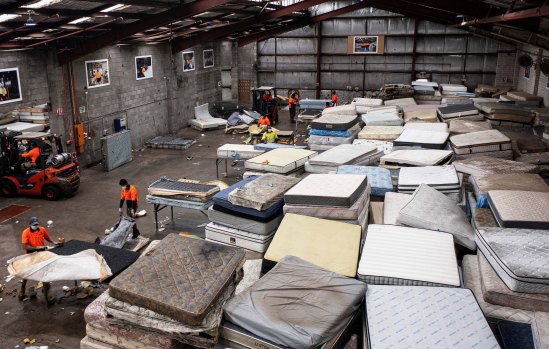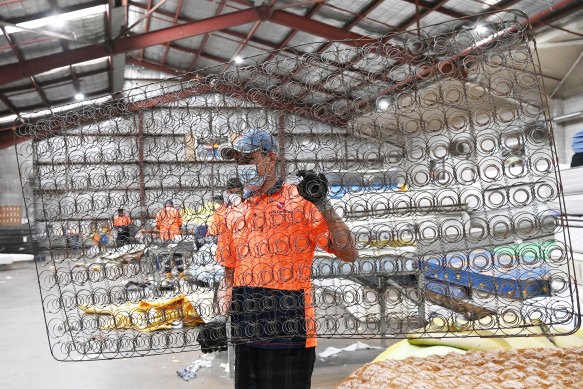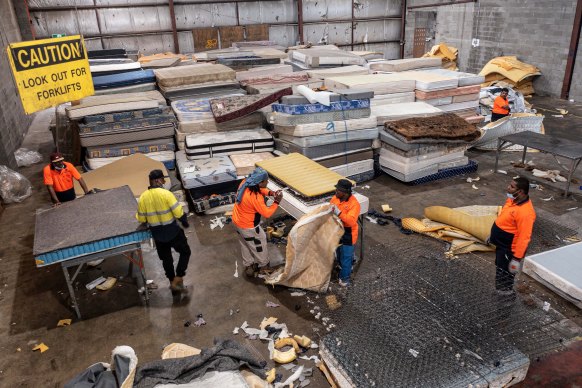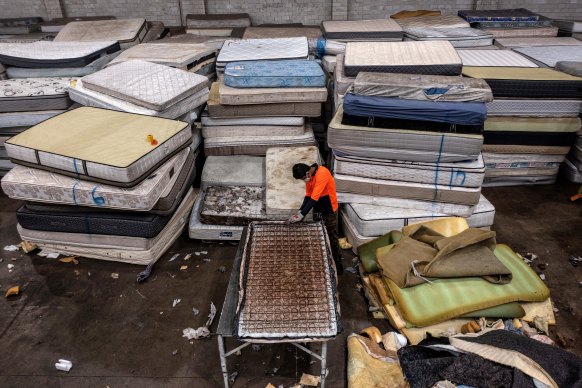Joe Rasmussen has never had the urge to throw himself from the top of the stairs of his Smithfield warehouse onto the piles of mattresses that cover the floor.
“They’ve been people’s beds for 10 or 15 years, and then they’ve been in this fairly dusty environment, so they’re pretty disgusting,” he said.
“It’s not a glamorous industry.”

Soft Landing recycled 538,000 mattresses across all of its sites last year.Credit: Nick Moir
Not a glamorous one, but perhaps a virtuous one. Mr Rasmussen is the NSW State Manager for Soft Landing, which handles around half the market share of the mattress recycling business in Australia.
Mattresses are one of the greediest waste items in terms of the landfill space that they occupy. Their high volume to weight ratio makes them expensive to move and, once buried, their low density compromises the civil engineering of the landfill.
But they are also one of the trickiest household items to recycle. Once the steel and foam have been removed, there is little remaining value in the contents of a mattress.

Soft landing strips the useful foam and metal from old mattresses. Credit: Nick Moir
The Australian Bedding Stewardship Council estimates that around 1.8 million mattresses are thrown out each year in Australia (though estimates vary, with Planet Ark claiming “more than 1 million”), and around 40 per cent of them – 22,140 tonnes – end up in landfill.
But the bedding industry is attempting to reduce the amount of landfill by creating a circular economy for mattresses, which involves consumers, retailers, manufacturers and importers in appropriately re-using them or recycling their materials.
Australian Bedding Stewardship Council program manager Janelle Wallace said that, under the new model, manufacturers and importers might pay a fee that would go towards rebates and recycling, as well as research and development on alternative uses for mattress materials.
“If you break down a battery, there’s a lot of value on those materials,” Ms Wallace said.
“There’s not a lot of value in dirty, grubby materials that come out of mattresses.”

Mattress recycling “is not a glamorous industry”. Credit: Nick Moir
Soft Landing collected and recycled the material from more than 538,000 mattresses last year, recovering thousands of tonnes of steel, foam and timber back into the circular economy. Its largest site in Smithfield, which is staffed predominantly by humanitarian migrant workers, receives 750 to 1000 mattresses each day.
Mattress by mattress, the workers use pliers, box-cutters and knives to rip out the bedding. Foam is chipped and sent off to become carpet underlay. Timber is chipped and used as daily cover in landfill or mulched for garden and animal bedding.
The springs are compressed in a steel press that acts like a giant sandwich press. First the steel is flattened, then it is compressed into the shape of a sausage and finally pushed into a 120kg square, comprising eight or nine mattresses.

Mattresses are one of the greediest waste items in terms of the landfill space that they occupy.Credit: Nick Moir
The bedding material – known as “flock” – is more of a conundrum. It is baled up and sent to landfill, though Mr Rasmussen is constantly considering how it might be repurposed. A coach-builder is currently exploring whether the polyethylene could be used for train seating. Mr Rasmussen keeps on his desk a greenish-grey block of “gunk” that was produced by melting down the foam and bedding.
“Could you use it as a crash barrier? Could you use it as a building material?”
But the gases produced in the melting process would need to be addressed.
With the price of landfill more than $200 per tonne, there is a commercial imperative to find better solutions. Mr Rasmussen, who was trained in economics and also worked as a primary teacher, said the economics of mattress recycling were challenging. The materials pulled out of each mattress were only worth $3.
“It’s not like an aluminium can, where the materials are more valuable than the logistics of dealing with it. It’s the opposite of that. A mattress is a very, very expensive way of getting your hands on some steel and foam.”
The Morning Edition newsletter is our guide to the day’s most important and interesting stories, analysis and insights. Sign up here.